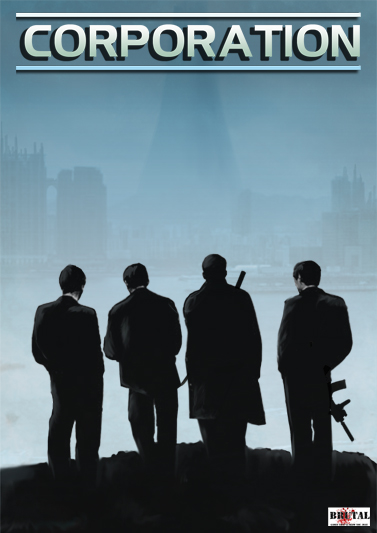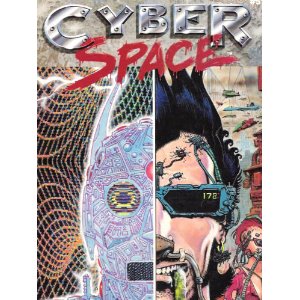Please include your name in the transaction description if using this to pay your membership.
rpgrev's blog
Corporation Review
Tue, 12/28/2010 - 00:22 — rpgrev
The Product
Corporation is released by Mongoose Games, under their Flaming Cobra of independents, in this case, Brutal Games. It's a beautifully bound hardback, absolutely rock solid in production qualities and lies quite flat when opened. The 256 page text is two column justified, sans-serif (not a good look for print, great for online), with boxed page numbers and chapter titles in the modest margins, top right and top left respectively. This is supplemented by boxed italic text providing short, descriptive narratives, and sectioned text to highlight specific rules. The cover is simple but evocative, a group of four Agents (think covert ops, men in black etc) overlooking a misty river with a spire and an old city in the background. The internal art is competent and evocative, presenting the cyberpunk and special agent setting which is central to the game. Unfortunately the printing is far too dark and much of the detail of the internal artwork has been lost in production. I've been told the clarity of the artwork is superior in the full-colour PDF version of the game.
The book is broken up into thirteen chapters, made explicit by a very clear two-page table of contents, with a three page index supplementing. After a brief introduction the game dives right into Character Generation followed by four chapters assisting the process (Equipment, Cybernetics, Telepathics, Character Advancement), and two chapters of central setting information for characters (The Corporations, the UIG and the Order of the Truth Faith). It is well into the book (chapter 8, p137) until the actual game system is explained, and this brief chapter (13 pages) is followed by supplementary setting information for the next three (The World in 2500, The Cities, People and Places). The last two chapters are GM aids, including sample scenarios and sample NPCs (Running Corporation, Antagonists).
Cyberspace Review
Tue, 12/28/2010 - 00:16 — rpgrevThere was a time in the late 1980s when there was quite a run on cyberpunk roleplaying games; Cyberpunk (1st edition and 20.20), and Shadowrun were, of course, the big names, and even Traveller 2300 (2300AD) decided to have a shot with the Earth/Cybertech supplement. From the ICE corner of the publishing market, came Cyberspace. It did strike as a little contrived and incongruous at the time. After all, ICE was known for their detail-heavy Rolemaster fantasy RPG, their Middle-Earth line, and a rather space operatic Spacemaster. Nevertheless, author Todd Foley (previously responsible for War on A Distant Moon and Beyond The Core for Spacemaster) stepped up to the task, with a stripped down version of the 'Master' system supplemented with cyberpunk setting and style.

Cyberspace came in a 206 page softcover with cover art from Rick Veitch, representing a juxtaposition of the crowded, polluted cybernetic environment and the abstract neon of cyberspace. It shows some creativity, but the technique is very much comic-book style, which is the illustrator's area of work. The interior art, by Rick Lowry, Angela Bostick, Del Harris, and Karl Martin, is nearly all good, giving a good sense of the style of cyberpunk with some images reminiscent of scenes from books and films of the time. The text is mostly presented in three-column ragged-right with an somewhat annoying sans-serif font, made up however by very clear and common sub-section headings along with obvious chapters heading and numbers on each page. Despite the density of the text finding the relevant material during play was as easily acquired skill.
After a short preface there are six chapters, The System, Running The World, Technology, Cyberspace, an Adventure and some very handy Appendices. These are supplemented by a good two-page table of contents and a somewhat short one page index. The writing style in the rules is mostly formal, to the point but supplemented with plenty of examples. There are thankfully short narratives introducing each chapter along with interesting occasional box-sections outlining annual events up to the year 2090, when the game is set.
The History and Resurrection of RuneQuest!
Sat, 12/30/2006 - 13:00 — rpgrevTo be published in Phantasmagoria 2006: The Annual of Murdoch Alternative Reality Society
Role Playing and Religion
Sat, 08/20/2005 - 14:00 — rpgrevRole Playing at the Melbourne Unitarian Church
Historical Fantasy Campaigns for Role Playing Simulations
Mon, 12/22/2003 - 13:00 — rpgrevPublished in "Phantasmagoria" Murdoch Alternative Reality Society Annual, 2004, pp32-38
Why Historical Fantasy?
This article starts with an aesthetic opposition to modern fantasy.
Literary Critique and Improvements in the Fellowship of the Ring
Wed, 02/27/2002 - 13:00 — rpgrevAbstract
The classic fantasy text of the twentieth century, the Lord of the Rings, suffers from notable literary flaws. The current portrayal of the first book of the trilogy by Peter Jackson, ‘The Fellowship of the Ring’, is a substantial improvement that manages to overcome Tolkien’s own biases and intellectual failings, yet also makes additional use of Tolkien’s heretical Catholicism.
The Social Psychology of Alignment
Mon, 06/29/1998 - 14:00 — rpgrevPublished in Mimesis Issue 2 (online), June 1998
Abstract
The formulation of moral alignments is as varied in roleplaying games as it is in behavioural psychology and the philosophy of ethics. Both universal and context bound models require assessment on quantitative and qualitative scales. Comparative evaluations through social simulation models, such as role playing games, may allow for a consistent synthesis of existing approaches.
